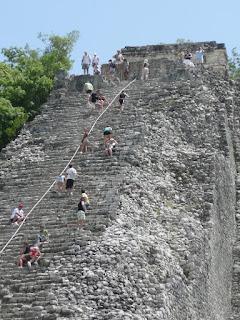At the height of its power, between 600 to 900AD, the Mayan city of Coba supported more than 45,000 people. Then, for some unknown reason, it was abandoned in the jungle and remained hidden until the 1890s. Excavations finally began in earnest in the 1970s, eventually restoring more than 30 structures. Researchers believe that at least another 6500 remain hidden in more than 50 square kilometres of dense jungle. Today, after 90 minutes of highway driving, I got to see this remarkable inland city for myself (Garry remained poolside in Cancun).
Coba is most famous for its stepped pyramid, known appropriately as Nohoch Mul, or the 'big mound'. This remarkable stone structure rises an impressive 42 metres above the jungle floor, offering an unobstructed view of the northern Yucatan Peninsula. I naturally had to climb it. No fewer than 120 steep, uneven steps lead to a surprisingly broad platform, from which a small stone temple looks out across the jungle skyline.
From here you can see how unbelievably flat the Yucatan Peninsular is. There isn't a single hill in any direction for as far as the eye can see. My guide explained that any tree-clad mound we could see rising above the treetops was, in fact, an unrestored pyramid. I could also see a small grey-stone pyramid bursting from the jungle about 500 metres away. I later learnt that this is one of the only pyramids left in the region that tourists are still permitted to climb.
Other sights of note at Coba included two restored ball courts. These structures feature two parallel sloping walls, each capped by a large stone hoop. Two teams played against each other using only their hips and elbows to get a rubber ball through the hoop. This was clearly an athletic endeavour as the walls rise almost ten metres, with a rather dramatic gradient.
Incredibly, the game typically ended with a human sacrifice. Researchers are unsure who was sacrificed; the team captain or the entire squad. Equally, nobody can be sure if it was the winners or the losers who offered the sacrifice. My guide believes that the winning team offered human sacrifice because such an act was considered an honour in Mayan culture.
Our final stop in Coba was another giant pyramid. This is not open to the public but sits at the end of an impressive, long-stepped platform extending almost 100 metres into the jungle. I was captivated by a series of hardwood trees growing over the top of a narrow archway next door. This simple sight offered a tantalizing glimpse of how the jungle had once smothered the entire area.
From Coba, we ventured to the coast where the Mayan port city of Tulum can be found. These well-preserved ruins perch on the edge of a steep cliff overlooking the most spectacular turquoise-blue sea. A small white sand beach cove offers the only seaward entrance to the site, while the city's three remaining boundaries are protected by an impressive stone wall. The wall is seven metres thick and up to five metres high, with only five gates offering access via a narrow passageway.
The site is dominated by another stepped pyramid, El Castillo, which is topped by a collonaded temple. This temple also served as a lighthouse, guiding Mayan canoes through a small gap in the offshore coral reef. The entire structure rises from a series of equally impressive stone platforms. Spanish sailors first sighted the city in 1518. Within 75 years it was abandoned as Spain ruthlessly conquered the region.
My guide explained that the city buildings had once been boldly painted red, blue and white. Today, just the occasional faded fleck of paint can be seen on the odd stone. The sight must have truly astonished Spanish explorers. However, the sight that astonished me today could be found directly outside Tulum's ruins - the Voladores.
These are five costumed men who recreate an unusual ceremonial ritual from the top of a towering blue pole. Four men wind ropes around the top of the pole, then tie them to their feet and slowly lower themselves to the ground by spiralling around the pole. Meanwhile, the fifth man stands on a tiny platform at the top of the pole, simultaneously dancing and playing a flute. It was difficult to decide which person was the boldest, or perhaps more appropriately, the most insane.
Click here to read about our overnight tour of Chichen Itza.
Incredibly, the game typically ended with a human sacrifice. Researchers are unsure who was sacrificed; the team captain or the entire squad. Equally, nobody can be sure if it was the winners or the losers who offered the sacrifice. My guide believes that the winning team offered human sacrifice because such an act was considered an honour in Mayan culture.
Click here to read about our overnight tour of Chichen Itza.
NOTE: February 2025
I recently began retrospectively resizing old blog images. My original photos were saved using an extremely low resolution. I've discovered that a handful of original images were overwritten by accident. As a result, two photos in this post have been reworked using AI to restore them as higher-resolution files. This includes the image of me sitting on top of a pyramid. These days I save blog images as 1000x750px files at least 250KB.






















No comments:
Post a Comment